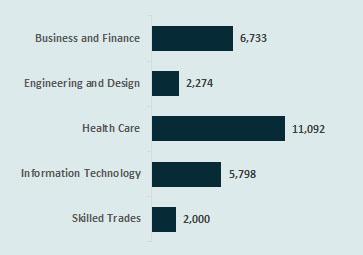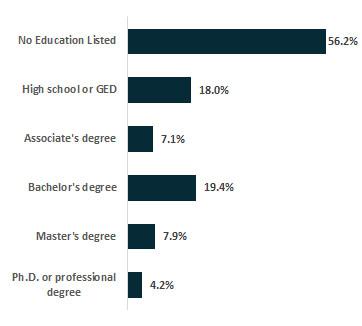
1 minute read
Key Findings
Employer demand decreased by 19.7 percent, a loss of 16,707 job postings since 2019. Health Care is the top posting occupation group through 2020 with 11,092 postings.
During 2020, there were 68,284 job postings, 16,707 less than the 84,991 postings made during 2019 in Washtenaw county. October 2020 saw the highest demand with 14,640 postings since the shut down due to COVID-19, however, postings are still down 12.3 percent since October 2019. The top posted job titles in 2020 include CDL-A Truck Drivers, Nannies, Delivery Drivers, Registered Nurses, and Child Care Professionals. For more information about in-demand job postings, see page 9.
Job postings made by employers in Washtenaw county indicate a bachelor’s degree remains the most in-demand minimum education level during 2020.
Of the 68,284 unique postings in Washtenaw county during 2020, 12,281 (18.0 percent) required a high school diploma or equivalent, while 18,118 postings (26.5 percent) required a college degree. An additional 8,234 postings (12.1 percent) required an advanced degree. The high demand for health care roles within the county, drives this high demand for workers with various skillsets.
Postings by Occupation Group 2020
Education Levels In-Demand 2020

Employment in Washtenaw county totaled 190,696 in Q4 2020, a decrease of 2,320 workers (1.2 percent) since Q4 2019.
The quarterly labor market has seen shifts following the outbreak of COVID-19. The first quarter of 2020 saw a slight increase in the labor force and employment, while unemployment and the unemployment rate also rose 0.1 percentage points. The COVID-19 shutdown, which started in Q2 2020, caused the employment in Washtenaw county to drop from 195,913 workers in Q1 to 172,086 workers in Q2, a decrease of 23,827 workers or 12.2 percent. Unemployment rose by 20,939 workers, more than triple the 4,732 workers recorded in Q1. Similarly, the unemployment rate rose in Q2, up from 2.4 percent in Q1 to 13.0 percent in Q2 2020. Since Q3 2020, the market has slowly begun to realign toward pre-pandemic levels, showing a decrease in unemployment and the unemployment rate through Q4 2020. For more information about this year’s unemployment rate and other labor market indicators, see page 4.
Quarterly Labor Market Data







